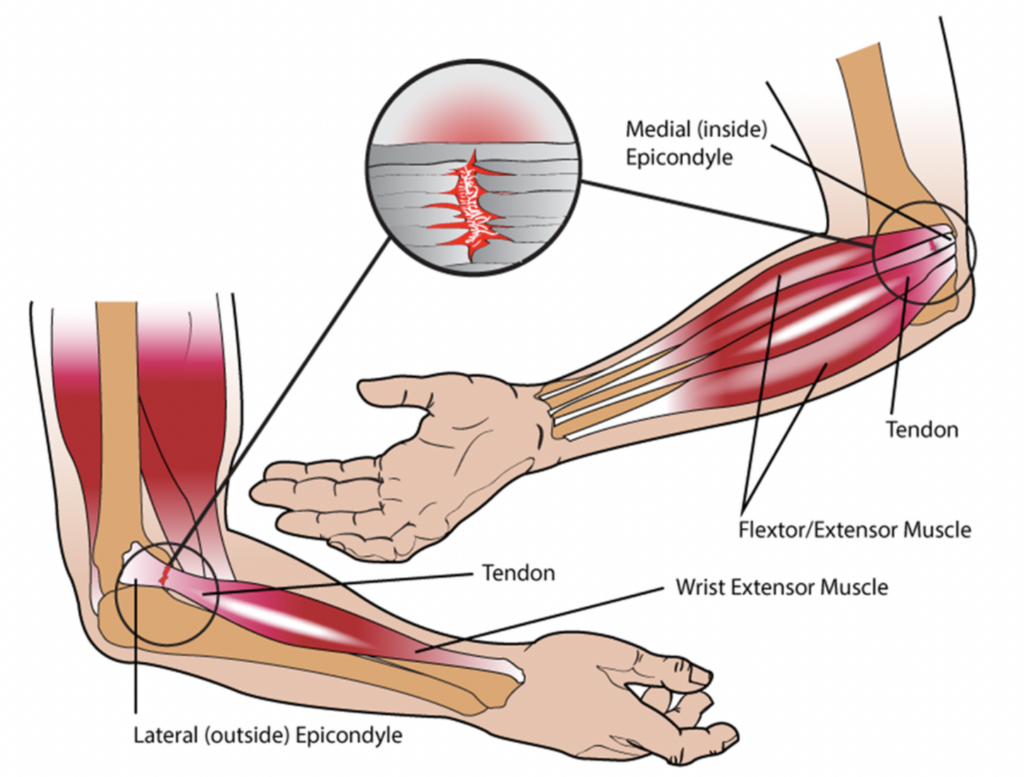Lateral Elbow Pain with Graded Exercise
Chronic tennis elbow with a supervised graded exercise protocol
Özdinçler, A. R., Baktır, Z. S., Mutlu, E. K., & Koçyiğit, A. (2023). Chronic lateral elbow tendinopathy with a supervised graded exercise protocol. Journal of Hand Therapy, 36(4), 913–922. https://doi.org/10.1016/j.jht.2022.11.005
The Skinny: This study looked at the effectiveness of an 8-week exercise program (4 weeks of a basic program and 4 weeks of an advanced program) for participants diagnosed with lateral epicondylalgia also known as tennis elbow without receiving treatment for at least one year. Pain was measured by the Visual Analog Scale, Pain Pressure Threshold, grip strength measurements using a Dynamometer, and the level of function determined with the Patient Rated Tennis Elbow Evaluation Questionnaire. All measurements were performed at baseline, after the 4-week basic program, and after the additional 4-week advanced exercise program.

In the Weeds: This study included 30 participants between the ages of 30-50 and all had a previous lateral epicondylalgia diagnosis. Participants were divided into 7 different phases depending on their ROM, stiffness, pain, and level of function. All participants received a basic exercise program for four weeks, three times per week. All exercises utilized an elastic finger band, 1 kg weight, hand exercise ball, or a towel. Those who completed the basic exercise program then began an advanced exercise program where stretching exercises, isotonic strengthening, concentric movements, and eccentric movements were included. Exercises included in the two programs were: AROM wrist extension, AROM wrist circumduction, AROM wrist radial and ulnar deviation, AROM forearm pronation, AROM forearm supination, isometric wrist extension, PROM wrist extension, eccentric and concentric wrist extension and flexion, finger extension with rubber bands, gripping with a ball, and towel squeezing/twisting.
Bringing it Home: Both in the basic exercise group and in the advanced exercise group, participants saw an improvement in pain and function. The basic exercise program was shown to ease the symptoms, while the advanced exercise program further benefited function and grip strength. It was proven that although both exercise programs were beneficial, the advanced group contributed to better results, especially in terms of grip strength, pain, and function. In addition, the study found that adding isometric exercises to the program early on was more beneficial than adding it at the halfway point.
Rating: 4/5
This study had several limitations, including a small sample size of 30 participants aged 30-50; no long-term follow-up to determine the chronic benefits of exercise for tennis elbow patients; and the main focus being wrist exercises and not including scapular exercises. Future studies could look at the long-term implications, adding phase of scapular exercises, and having a larger sample size for reliability.
More To Read
Creating an Action Plan for Addressing Mental Health in the Clinic
Blog By: Rachel Reed As hand therapists, our care for our patients must be driven by the goal of treating the whole person, not just their hand or injury (Hannah, 2011). Occupational therapy is a unique profession in which we are equipped to view our patients through a holistic lens. With this lens, we are…
Read MoreSensory Kit for Hypersensitivity
Written by Melissa Miller Introduction After injury or surgery, nerves in the skin and surrounding the injured area can become overly sensitive. This can cause pain or an unpleasant sensation by stimuli that would not typically cause discomfort. For example, a light touch from a shirt or a certain material can feel like needles to…
Read More7 Tips to Help your Patients Manage Hand Osteoarthritis
Introduction Osteoarthritis in the hands can be frustrating and debilitating. As a form of degenerative joint disease, it causes stiffness, pain, swelling, and reduced grip strength—making daily tasks like writing, opening jars, and typing feel exhausting. Fortunately, there’s a proven holistic approach centered on hand therapy for arthritic hands. This includes tailored exercises, targeted splinting,…
Read MoreTherapeutic Exercise vs Therapeutic Activity
What is the difference between therapeutic exercise vs therapeutic activity? Therapeutic exercise is billed as 97110 and Therapeutic activity is billed as 97530. Both are CPT codes that are commonly used in occupational and physical therapy billing. These codes are very similar and are often confused. So, when and what do you document for each…
Read MoreSign-up to Get Updates Straight to Your Inbox!
Sign up with us and we will send you regular blog posts on everything hand therapy, notices every time we upload new videos and tutorials, along with handout, protocols, and other useful information.






